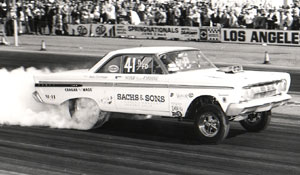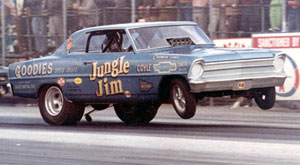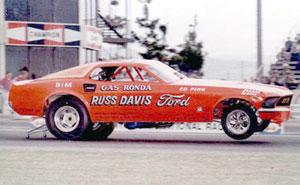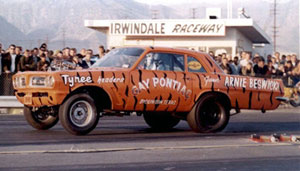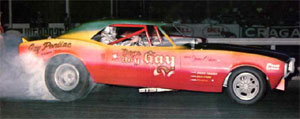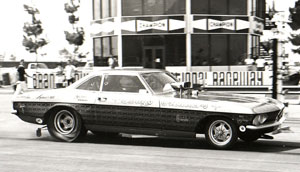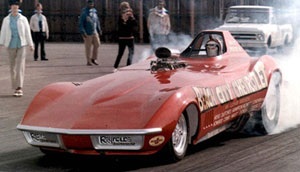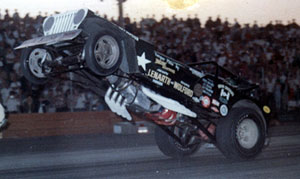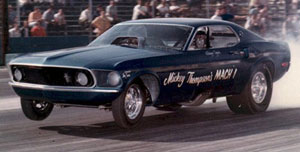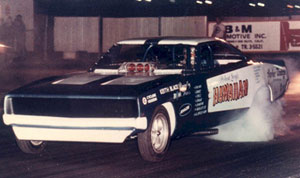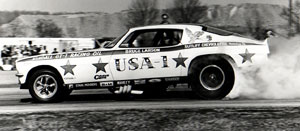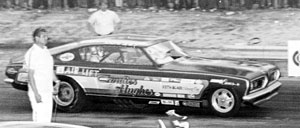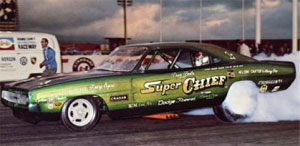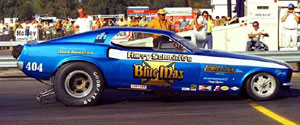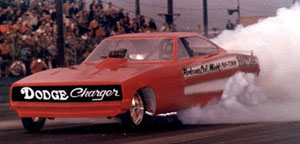

Favorite Race Car Ever voting: Early Funny Cars
|
|
||
|
|
||
|
|
||
|
|
||
|
|
||
|
|
||
|
|
||
|
|
||
| Final results for all-time favorite Early Funny Car | ||
| Jim Liberman’s '66 Chevy II |
755
|
(19.87%) |
| Blue Max ‘69 Mustang |
715
|
(18.82%) |
| Chi Town Hustler '69 Charger |
645
|
(16.97%) |
| Gas Ronda’s Ford Mustangs |
263
|
(6.92%) |
| Bruce Larson's USA-1 '69 Camaro |
202
|
(5.32%) |
| Sachs & Sons/Chrisman Mercury Comet |
199
|
(5.24%) |
| Ongais/Foster/Thompson'69 Mustangs |
179
|
(5.14%) |
| Roland Leong's Hawaiian '69 mini Charger |
159
|
(4.18%) |
| Arnie Beswick's Tameless Tiger '66 GTO |
153
|
(4.03%) |
| Mazmanian/Siroonian '69 Barracuda |
108
|
(2.84%) |
| Candies and Hughes '69 Barracuda |
115
|
(3.03%) |
| Doug Thorley’s '66 Corvair |
87
|
(2.29%) |
| Beach City Corvette |
72
|
(1.89%) |
| Nelson Carter’s Super Chief Chargers |
72
|
(1.89%) |
| Secret Weapon Jeep |
45
|
(1.18%) |
| Gay Bros. Infinity III ’67 ’rainbow’ Firebird |
32
|
(0.84%) |
|
Total Votes: 3800
|
||
|
|
||
|
|
||
|
|
||
|
|
||
|
|
||
|
|
||
|
|
||
|
|
||
Although nothing says “drag racing” like a Top Fuel dragster, there’s no denying the impact that the Funny Car class has had on the sport’s popularity during the years since its inception in the mid-1960s.
In April 1966, NHRA announced its first Funny Car classes, proposed to run in the Experimental Stock (XS) class, an outgrowth of the Factory Experimental classes that NHRA unveiled in 1964 to further Detroit’s interest in the sport. But the first “funny-looking cars” had been around before that as the factories tried to one-up one another with stock-appearing bodies hiding souped-up powertrains and sporting offset wheelbases and more in the class’ formative years, which led to the first supercharged factory experimentals (Super Factory Experimental, in NHRA’s lingo), which is where today’s Favorite Race Car Ever poll comes in, covering Early Funny Cars from 1964 through roughly the end of the decade.
As always, the readers of this column supplied the nominations (stop yelling at me for “forgetting” your favorite!), and there was no shortage of them, including several that surprised me in their popularity. So let’s all don our aluminized firesuits, strap on those breather face masks, and fire ‘em up.
Many call our first entry, the Jack Chrisman-driven Sachs & Sons Mercury Comet, the first real Funny Car and Chrisman “the father of the Funny Car,” and with good reason. Although the car did not have a full flip-top body as we know today’s Funny Cars, it did have a supercharged, nitro-burning engine and certainly opened the imagination box for what could be and was a huge fan favorite.
Chrisman was still mending after a painful 1963 accident in Pomona in the Yeakel Bros./Vince Rossi Spaghetti Benders slingshot and working at NHRA, where he met Ford’s Fran Hernandez and, through Helen Sachs’ Lincoln-Mercury dealership in Downey, Calif., which had been sponsoring FX cars for a couple of years, changed the sport. Chrisman enlisted the help of engine ace Gene Mooneyham and noted fabricator Bill Stroppe to shoehorn a blown nitro-burning 427 into a fiberglass-bodied ’64 Comet. The car did smoky burnouts and ran low 10s at 150 mph to wow the fans in Indy that year, and the installation of a rearward-mounted SOHC later pushed a lightened version of the car into the nines at more than 160 mph while all the time retaining a relatively stock appearance; the fans ate it up.
Bob Chrisman, Jack’s nephew, admits to being a little partial but still calls it his all-time fave. “A real stock-bodied passenger car, a blower, and a little nitro, and smoke those M&Hs almost the entire quarter-mile. A plain white two-door hardtop, a few decals, a little lettering, and that was it, but the seed was planted, and look where we are today.”
Jim Liberman began his Funny Car career as a hired gun wheeling a number of cars but really made his mark with the 1966 introduction of the first “Jungle Jim”-branded car, a steel-bodied, Chevy-powered Chevy II. After a national tour in 1967, “Jungle” became so popular with this car that by 1968 he hired Clare Sanders to drive a second similar entry.
Like many Funny Car pioneers, Gas Ronda was a former Super Stock racer who caught the wave early on. The Southern California driver began racing Funny Cars in 1966 and retired in early 1970 after a very nasty Funny Car fire at the 1970 AHRA Winternationals, but he left his mark on the scene with his Russ Davis-sponsored Mustang floppers, the first of which was built by Holman-Moody and featured a cool, flip-front clip, the early predecessor to the flip-top body. Ronda never won an NHRA national event with his cars but won several times at the prestigious OCIR Manufacturers Meets.
David “Scooter” West reminisces, “I saw this race car make many runs in SoCal during the early days of drag racing. I would hang out at OCIR and Lions on all the big race weekends. My most memorable memory of Gas Ronda was when I went to my local hobby shop and purchased the Revell model of the famed flopper. I hurried home to start building this plastic masterpiece. To my surprise, when I opened the box, there was a cardboard 45 rpm record in the box. The record had a picture of Gas Ronda on it, so this was going to be good! I hurried into my brother’s bedroom and played the record. It was a recording of the car doing a burnout with the announcer talking in the background, then the sound of the car making a pass. When I finished building the model, I took it back to the hobby shop where it sat on display in their front window for a couple of weeks. I had even put shredded cotton balls behind the rear tires to simulate the smoking burnout that Gas Ronda was famous for.”
Pontiac fanatic Arnie Beswick’s Tameless Tiger GTO was a match-race terror in the mid-1960s and has been credited in some corners with the first nine-second Funny Car run and, in a more modern and lighter form, eventually went as quick as 8.30s. Beswick, too, got his start in the Super Stock classes and was a participant at NHRA’s first “Winternationals,” a meet co-hosted by NASCAR in Florida, and his Tempest-body FX cars laid the groundwork for the GTO, which he built from a ’64 frame.
Recalls reader Dow Bancroft, “Here was a local guy, an independent, with a Pontiac no less, beating up on a lot of big-name cars. Arnie always had time for fans, and every run was a showpiece, win or lose. A real down-to-earth guy who loved to race.”
Another Pontiac stalwart team was that of the Gay brothers, Don and Roy, whose Texas-based machines ran out of the family Pontiac dealership in Dickinson, Texas (a fact that held true even through Don Gay Jr.’s short stint in the nitro ranks in the late 1980s), and ruled the Southwest. Don was just a teenager when he first began racing the family Pontiacs in Stock, then transitioned into altered-wheelbase cars and finally Funny Car, where they fielded a series of cars under the Infinity name; Roy took over the wheel of the nitroburner after a few years, and the car nominated here is their unique rainbow Infinity III Firebird from 1967.
The Corvair holds a special spot in American automobile history as the target of Ralph Nader’s scorn, but on the dragstrip, it’s fondly remembered under the reins of Doug Thorley as a car that ran as well as it looked. The Doug’s Headers Corvair won the 1967 U.S. Nationals with a stunning 7.69-second pass and ran well into the 190-mph range. Pat Foster built the car, which had tinted Plexiglas windows, a lace paint job, and gold painted Halibrand mags. “ ... the poster child of late-‘60s fads,” noted Danny White of 60sfunnycars.com. While it was not the only Corvair Funny Car – Terry Hedrick (Seaton’s Shaker), Hayden Proffitt, and others also wheeled Corvairs – it seems to be the most revered, at least among our readers. “Period-correct psychedelic paint scheme and amazing performances,” summarized reader Terry Spencer.
In the history of Funny Cars, there seems to be no more synonymous with the term “bad luck” than the fabled Beach City Corvette. Funny Car builder and painter Don Kirby fielded this topless Corvette with the backing of Beach City Chevrolet, but the cars, despite hosting a series of top-name shoes, repeatedly crashed or burned, including a particularly memorable incident that left the BCC burning on the interstate past the end of the Orange County Int’l Raceway shutdown area. Regardless, the car is fondly remembered for its sharp looks.
In 1966, Funny Cars were still trying to figure out who and what they were, and many body styles were tried for their ability to grab attention more than their ability to perform; chief among those was a line of Jeep-bodied floppers. And none was more famous than Roger Wolford’s and Ed Lenarth’s Secret Weapon. Despite being known for its inconsistency, the car actually won a few match races and ran low eights, but the Jeeps later were outlawed by NHRA.
Said James Williams of the car, “It was outrageous and loud, with Army green colors, high-gear only (unique for the era), and feared by its competitors.”
Funny Cars took a quantum leap forward with the 1969 debut of a pair of Mustangs – one red, the other blue -- built by Pat Foster for Mickey Thompson, one of which he drove and the other shoed by Danny Ongais. Built lighter and with narrower framerails and fitted with a dragster-like roll cage and zoomie headers, the cars revolutionized the class and ran into the sixes at more than 215 mph. Foster’s red mount was ill-fated, but Ongais’ blue bomber won the 1969 Springnationals and U.S. Nationals.
Opined Bob Nielsen, “I do not think Ongais knew how to lift his right foot off the accelerator once he left the starting line. Many times the car would be completely sideways, and one would think that he was going to hit the trackside rail for sure, but he would not lift and drive back to the middle of the lane and usually secure the win. I am sure that there were many trackside photographers that were given a little scare more than once when Ongais did this and needed to visit the dry cleaners afterwards!”
The car that Ongais defeated in that 1969 Indy final is another of our nominees, the Barracuda of “Big John” Mazmanian,” driven by his nephew, Rich Siroonian. The car, like all of “Big John’s” rides, sported his trademark candy-apple-red paint scheme and gold-leaf lettering; it was hot off a big win at OCIR’s Manufacturers Meet in 1968, but Siroonian red-lighted to Ongais in the final.
Win or lose, Alan Davidson still loves that car. “I went to my first drag race, Bakersfield March Meet in 1969, and that was my first exposure at actually seeing these cars go,” he recalled. “I had just read the mags before. That 'Cuda was gorgeous, candy-apple-red paint job. Siroonian had just won an event in SoCal and put on a great show. Burnouts, spectacular! The sights, the sounds, the smells just made me a fan forever. I go to each of the Pomona events and have for years, but that car sticks in my mind.”
Roland Leong’s Hawaiian entries had long been established as winners in Top Fuel, having accomplished an amazing feat of winning the Winternationals and U.S. Nationals back to back with different drivers (Don Prudhomme and Mike Snively) in 1965 and 1966, and the winning legacy continued into Funny Car. The first Hawaiian, a Logghe-built car with a full-size Charger body, kited in Pomona in a memorable, high-flying top-end accident at the 1969 Winternationals and was replaced with what was a dubbed a “mini Charger” body and a car that proved quite successful.
Twenty years before he would win the NHRA Funny Car world championship, Bruce Larson already was a star in 1969 with his USA-1 line of race cars. Larson had been racing since he was a teenager and had set national records in NHRA A/Sports and AA/Sports with a ’64 Cobra, but his Logghe-chassised, Chevy-powered ’68 Camaro Funny Car was truly a strong runner, especially on his native East Coast, where he recorded unprecedented elapsed times for the era, including a 7.41 that earned him national attention.
Recalled Texas reader Terry Barnes, “I received my first issue of Hot Rod Magazine in the fall of 1969, [which] had a picture of the USA-1 Camaro Funny Car ... it was love at first sight. I graduated from high school in May of 1972 and in August of the same year, I bought my Camaro, a 1969 Indy pace car version hardtop. In 1975, I started running a USA-1 license plate on the front of the car, our daily driver for many years. At the 2008 Hot Rod Reunion in Bowling Green -- and, yes, we drove the Camaro from Lubbock, Texas, and, yes, it had a USA-1 plate on the front-- I was walking in the pits, and there it was, the car that I had fallen in love with so many years ago. I was overcome with emotion; I just had to reach out and touch the car (sorry, Bruce). I couldn't believe that I was finally getting to see the car. I bought a silver Sharpie and took the glove compartment door off the car and took it back down in the pits, where Bruce graciously signed it for me. After 39 years, the circle was complete.”
The famed team of Paul Candies & Leonard Hughes fielded a lot of winning cars over the years, won a handful of championships, and with Hughes and team driver Larry Reyes, created the first all-team Funny Car final way back at the 1970 Gatornationals, and the car in this poll is the car that didn’t win -- their sleek fastback Barracuda driven by Reyes. Before Reyes drove it, Hughes powered the Logghe-chassised machine to low e.t. and top speed honors at Indianapolis in 1968 and top speed at the 1969 Winternationals and U.S. Nationals.
“I grew up in Houma, La., and lived near Leonard Hughes,” says Lance Peltier. “I remember before those guys built their shop, Leonard lived in a small house with no garage, only a carport. He would have that '69 ‘Cuda on jackstands under his carport, the body would lay in his front lawn and the ramp truck parked in the ditch along the street. At night he would just cover it up under the carport. It was extremely fast and won every race it entered at the new Houma track, Southland Dragways. C&H ended up campaigning many, many beautiful cars, but their ’69 is the one that really has a place in my heart.”
Nelson Carter's Super Chief Dodge Charger was one of Southern California’s most colorful Funny Cars, sporting a myriad of eye-catching paint schemes, many of which included the dreaded color green and was shoed in its inception by another guy with green in his blood, Dave Beebe. Later versions were driven by the likes of Gary Burgin, Tom Grose, Ron O’Donnell, Bob Pickett, Steve “Okie” Bernd, and others.
Say “Blue Max” to most Funny Car fans, and they’ll quickly answer back with “Raymond Beadle,” but Harry Schmidt’s blue monster flew long before the gregarious Texan powered it to three world championships in the late 1970s. Jake Johnston and Richard Tharp wheeled early versions of the Max in the late 1960s and early 1970s and were big winners on the match-race trail and helped build the foundation for what was to come.
And last, and certainly not least, is the famed Chi-Town Hustler of John Farkonas, Austin Coil, and Pat Minick, whose '69 Dodge Charger wowed late-1960s fans with incredibly long and smoky burnouts. Coil, now of John Force fame, of course, was the tuner back then and Minick the driver, and although the car ran hard, in the sixes at over 200 mph, it’s best remembered for its showy burnouts.
Many thanks to Bob Plumer/Drag Race Memories for the use of some of the photos here and to Danny White’s site for the research. Okay, there you have it … the 16 entries for our Early Funny Cars ballot. The floor is yours!




















































